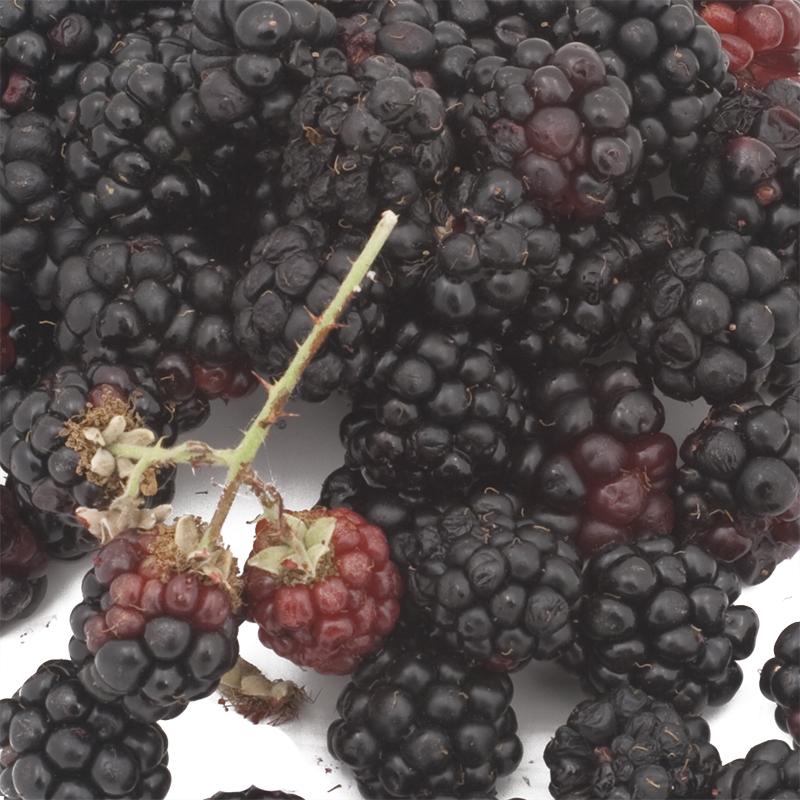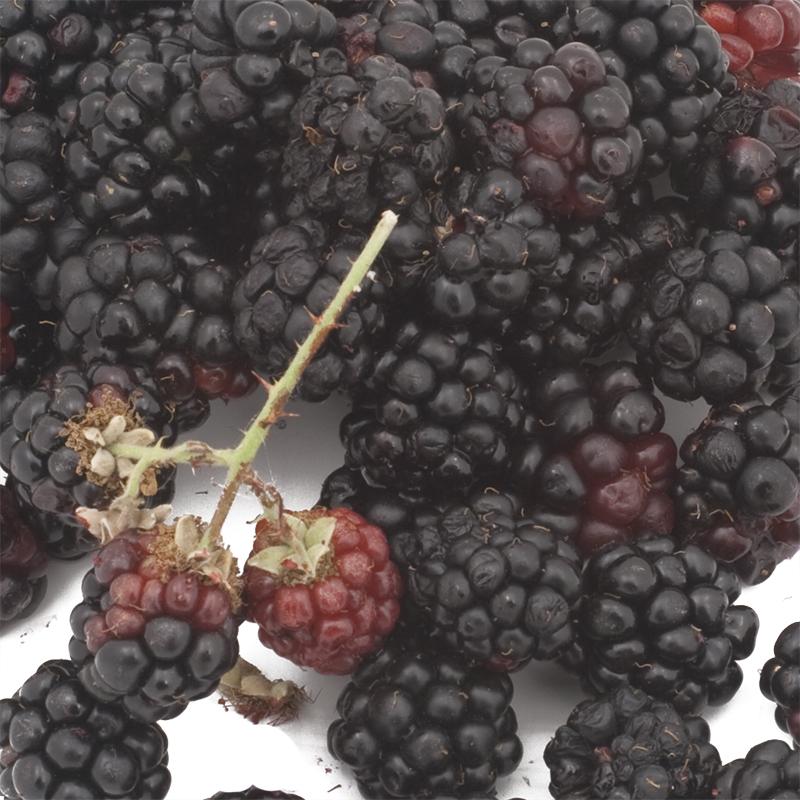Item Number: FV307
Marionberry
Marionberry
Has an Earthy Tart Sweet Flavor
- Zones: 6-9
- Harvest: Ripens in July and early August
- Fruit: Medium-large, bright black berries with an earthy tart sweet flavor.
- Facts of note: A vigorous trailing vine (with thorns) that grows up to 20' long. Good for local fresh markets, canning, freezing, pies, ice cream flavoring, jams and jellies. Good shelf life. High quality, with flavor superior to Boysenberry. A cane berry hybrid from crossing 'Chehalem' and 'Olallie' blackberries developed in 1945 at Oregon State University.
- Plants are 2 year, grade #1
For more information, please enjoy our Growing Guide for planting and growing blackberries.
Growing Marionberries: A Guide to Cultivating Flavorful Delights
Marionberries, renowned for their deep flavor and juicy berries, are a delightful addition to any garden. This cane berry hybrid, resulting from the crossbreeding of 'Chehalem' and 'Olallie' blackberries in 1945 at Oregon State University, has gained popularity for its superior taste and adaptability. To successfully cultivate Marionberries, one must understand the plant's characteristics, ideal growing conditions, and proper harvesting techniques.
Plant Characteristics:
Marionberries are characterized by medium to large, bright black berries with an earthy tart-sweet flavor. The berries are highly versatile and suitable for local fresh markets, canning, freezing, pies, ice cream flavoring, jams, and jellies. The plant itself is a vigorous trailing vine that can grow up to 20 feet in length. It's important to note that Marionberries come with thorns, adding an extra layer of consideration for growers. The origins of Marionberries trace back to Oregon, where they were developed as a result of meticulous crossbreeding. The parentage includes the 'Chehalem' and 'Olallie' blackberries, and this hybrid has proven to be a high-quality cultivar with a flavor superior to the well-known Boysenberry.
Growing Conditions:
To cultivate Marionberries successfully, it is crucial to provide the right growing conditions. These plants thrive in Zones 6-9, making them suitable for various climates. When selecting a location for planting, opt for well-drained, fertile soil that receives full sun exposure. Marionberries flourish when the soil has good drainage, preventing waterlogged conditions that can harm the roots. Regular watering is essential for Marionberry bushes. Keep the soil consistently moist, especially during dry periods, to ensure optimal growth. However, it's equally important to avoid waterlogged conditions, which can lead to root rot. Pruning plays a vital role in maintaining the health of Marionberry plants and encouraging fruit production. These vigorous trailing vines can benefit from pruning to manage their growth and increase airflow, reducing the risk of diseases. Prune the canes in late winter or early spring, removing dead or weak canes and shaping the plant for better sunlight penetration.
Harvesting Marionberries:
Marionberries typically bear fruit in the summer, offering a long harvest season that extends from June through the summer months. Harvesting should be timed carefully to ensure the berries reach peak ripeness. Look for fully blackened berries that are firm and plump. Marionberries are known for their sweet and bright flavor, making them excellent for fresh consumption, desserts, pies, and various culinary applications. When harvesting Marionberries, use clean, sharp pruning shears to cut the berries from the plant. Be gentle to avoid damaging the delicate berries and surrounding foliage. Due to the thornless nature of Marionberry bushes, the harvesting process becomes more user-friendly compared to other blackberry varieties.
Growing Marionberries can be a fulfilling endeavor for garden enthusiasts. With their thornless nature, superior flavor, and adaptability, Marionberries are well-suited for novice and experienced gardeners. Understanding the plant's characteristics, providing the right growing conditions, and practicing proper harvesting techniques are key to a successful Marionberry cultivation experience.
For more information, please enjoy our Growing Guide for planting and growing blackberries.


Check Your Zone Compatibility:
Compatible with your zone.
Growing Zone for
,

Our Guarantee To You
Since 1976, we've served our customers at every stage of growing. Please contact us at any time. We are happy to support and assist you.
Description
Description
- Zones: 6-9
- Harvest: Ripens in July and early August
- Fruit: Medium-large, bright black berries with an earthy tart sweet flavor.
- Facts of note: A vigorous trailing vine (with thorns) that grows up to 20' long. Good for local fresh markets, canning, freezing, pies, ice cream flavoring, jams and jellies. Good shelf life. High quality, with flavor superior to Boysenberry. A cane berry hybrid from crossing 'Chehalem' and 'Olallie' blackberries developed in 1945 at Oregon State University.
- Plants are 2 year, grade #1
For more information, please enjoy our Growing Guide for planting and growing blackberries.
Growing Marionberries: A Guide to Cultivating Flavorful Delights
Marionberries, renowned for their deep flavor and juicy berries, are a delightful addition to any garden. This cane berry hybrid, resulting from the crossbreeding of 'Chehalem' and 'Olallie' blackberries in 1945 at Oregon State University, has gained popularity for its superior taste and adaptability. To successfully cultivate Marionberries, one must understand the plant's characteristics, ideal growing conditions, and proper harvesting techniques.
Plant Characteristics:
Marionberries are characterized by medium to large, bright black berries with an earthy tart-sweet flavor. The berries are highly versatile and suitable for local fresh markets, canning, freezing, pies, ice cream flavoring, jams, and jellies. The plant itself is a vigorous trailing vine that can grow up to 20 feet in length. It's important to note that Marionberries come with thorns, adding an extra layer of consideration for growers. The origins of Marionberries trace back to Oregon, where they were developed as a result of meticulous crossbreeding. The parentage includes the 'Chehalem' and 'Olallie' blackberries, and this hybrid has proven to be a high-quality cultivar with a flavor superior to the well-known Boysenberry.
Growing Conditions:
To cultivate Marionberries successfully, it is crucial to provide the right growing conditions. These plants thrive in Zones 6-9, making them suitable for various climates. When selecting a location for planting, opt for well-drained, fertile soil that receives full sun exposure. Marionberries flourish when the soil has good drainage, preventing waterlogged conditions that can harm the roots. Regular watering is essential for Marionberry bushes. Keep the soil consistently moist, especially during dry periods, to ensure optimal growth. However, it's equally important to avoid waterlogged conditions, which can lead to root rot. Pruning plays a vital role in maintaining the health of Marionberry plants and encouraging fruit production. These vigorous trailing vines can benefit from pruning to manage their growth and increase airflow, reducing the risk of diseases. Prune the canes in late winter or early spring, removing dead or weak canes and shaping the plant for better sunlight penetration.
Harvesting Marionberries:
Marionberries typically bear fruit in the summer, offering a long harvest season that extends from June through the summer months. Harvesting should be timed carefully to ensure the berries reach peak ripeness. Look for fully blackened berries that are firm and plump. Marionberries are known for their sweet and bright flavor, making them excellent for fresh consumption, desserts, pies, and various culinary applications. When harvesting Marionberries, use clean, sharp pruning shears to cut the berries from the plant. Be gentle to avoid damaging the delicate berries and surrounding foliage. Due to the thornless nature of Marionberry bushes, the harvesting process becomes more user-friendly compared to other blackberry varieties.
Growing Marionberries can be a fulfilling endeavor for garden enthusiasts. With their thornless nature, superior flavor, and adaptability, Marionberries are well-suited for novice and experienced gardeners. Understanding the plant's characteristics, providing the right growing conditions, and practicing proper harvesting techniques are key to a successful Marionberry cultivation experience.
For more information, please enjoy our Growing Guide for planting and growing blackberries.
Shipping Information
Shipping Information
Shipping Weight: 2.0 lb
Features
Features
- Container Compatible
- Easily Established
- Plant Spreads
- Self-fruitful
Characteristics
Characteristics
Planting & Care
Planting & Care
Useful Information
Useful Information
Guarantee
Guarantee
Share


